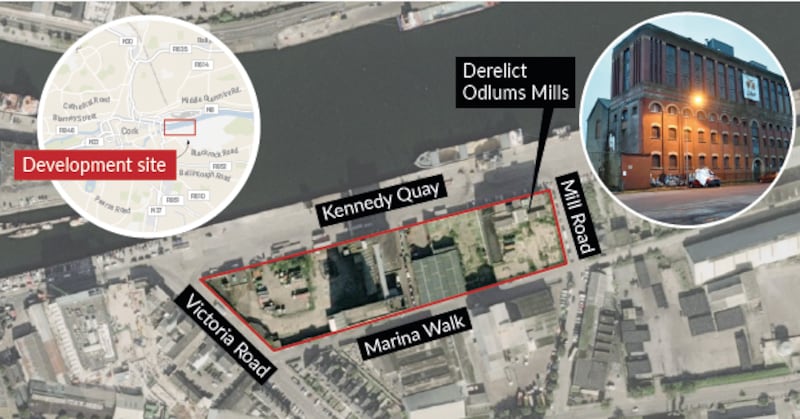The revitalisation of the Cork Docklands has received a major boost with confirmation by O’Callaghan Properties that it is to apply for planning permission for a €350 million project on the city’s South Docks, incorporating a hospital, office blocks and residential units.
Brian O’Callaghan, MD of O’Callaghan Properties, said the project, which has the potential to create 5,000 new jobs on completion, will involve a 1 million sq ft development on a 4.162-acre site at Kennedy Quay with the potential to transform the area into a major driver of economic activity.
Mr O'Callaghan explained that the project will involve building a 122,000sq ft, 130-bed private rehabilitation hospital, to be run by French healthcare company Orpea Group as well as 450,000sq ft of office space and 80,000sq ft of residential development.
The main office accommodation will be distributed among three buildings ranging in height from nine to 12 storeys while the new apartment development, comprising 80 “build to sell” apartments, will be contained within an 11-storey tower block, he said.
Mr O’Callaghan revealed that the project will also involve the restoration and re-purposing of the derelict Odlums Mills to create two seven- and nine-storey buildings incorporating some 84 one-, two- and three-bedroom apartments as well as a cinema, food hall and office space.

“South Docks has played a key role in the social and working life of Cork and has constantly evolved and changed. The area has moved from industrial use to the ‘new economy’ – our project not only facilitates that journey but creates a new focal point for the city, a new, sustainable amenity of scale,” said Mr O’Callaghan.
“This project provides compelling new options for FDI and indigenous investment and makes a very clear statement about the city and the business opportunities in optimal locations outside of Dublin, in the post-Covid and post-Brexit period,” he added.
“The South Docks location is also capable of making serious inroads into residential shortages in the city and we hope to provide over 2,000 homes on this site and we intend to submit a further planning application for these in the new year,” he said.
Regarding the first phase, Mr O’Callaghan said the Odlums building, which operated from 1933 until 2009, is not a simple structure but once it is stripped back and isolated, it does offer the opportunity for re-use and extension with little or no impact on the quality of the original structure.
He said that unlike modern grain storage silos, the Odlums building was designed along traditional 19th-century lines, with floors installed at regular levels with windows for ventilation and drying, and it was proposed to retain all of the historic fabric at the front, rear and side facades of the original building.
However, unlike the Odlums building, it was found that the nearby R&H Hall silos, which are 90 years old, are suffering from structural issues, which makes a viable re-purposing of them impossible to achieve, and O’Callaghan Properties will apply for permission to demolish them.
Concrete walls
According to O’Callaghan Properties, a survey of the R&H Hall silos found that the 33.3-metre high buildings are constructed as a series of simple concrete walls with no independent structural frame though there are some internal supports involving steel beams and short columns.
“In essence, the silos are monolithic concrete structures bound together by a honeycomb of internal supports. If part or all of the internal grid of diaphragm walls is moved so as to facilitate alternative uses and to comply with current building standards, the entire structure becomes unstable.”
An O’Callaghan Properties spokesman said all the engineering and technical reports on the R&H Hall silos, which also detail deterioration in the concrete in the building, will be supplied to Cork City Council in support of the planning application and as a result will become part of the public record.
Meanwhile it was revealed that the rehabilitation hospital, which will be run by Orpea, will comprise 130 individual patient rooms and will provide stroke, acquired brain injury and general neurological rehabilitation. It will be only the second such dedicated facility in the country.
Emmanuel Masson, Orpea’s executive vice president of expansion and network development, said the company was pleased to be involved in the development, which will also include a dedicated outpatients’ day hospital as well as a gymnasium, occupational therapy suite and hydrotherapy pool.
“We believe the riverside location of the hospital will be a great advantage to patients and staff. In fact, the design of the hospital is configured so that each of the patients’ rooms will have a river view, which will underpin the positive healing environment we seek to create in each of our facilities.”









